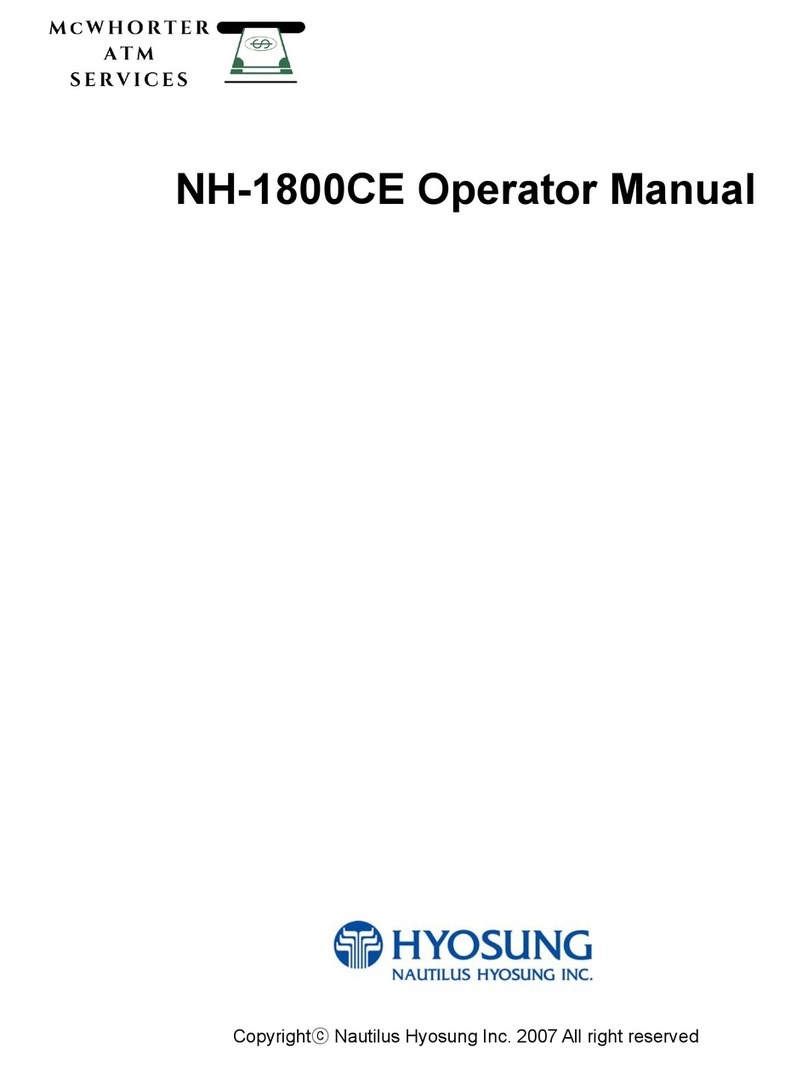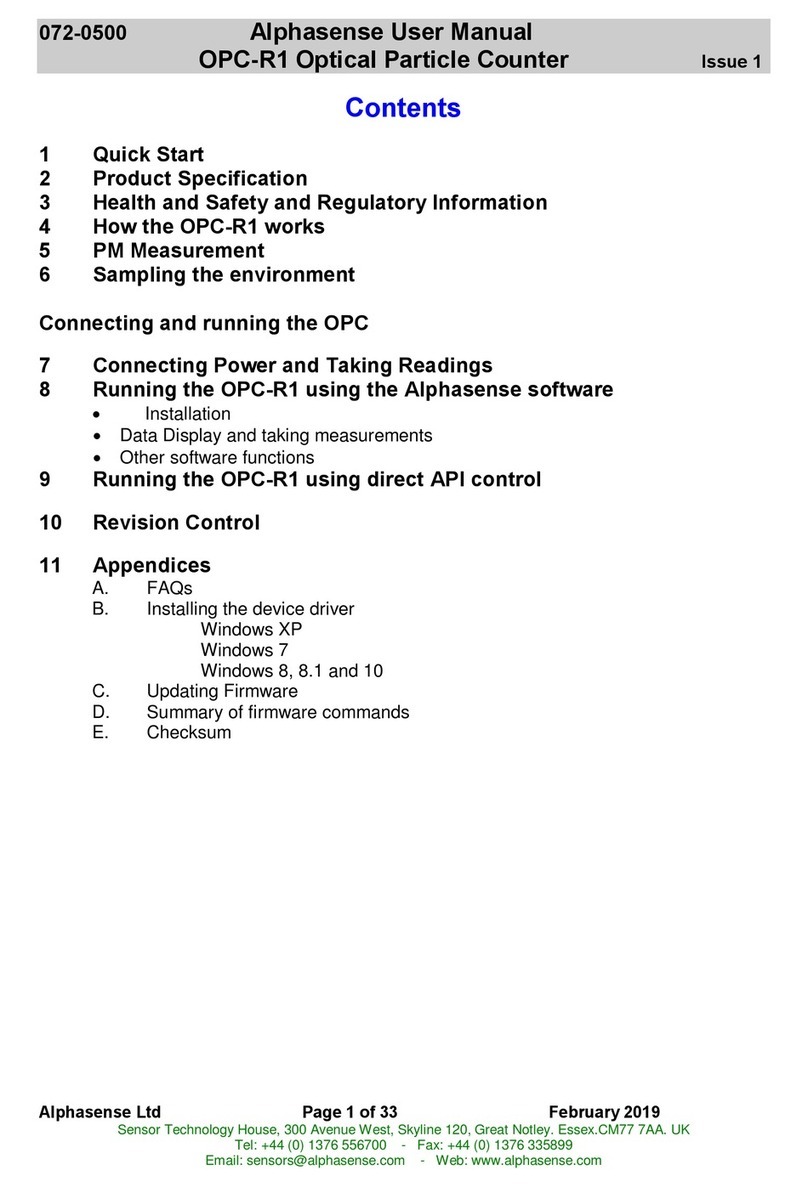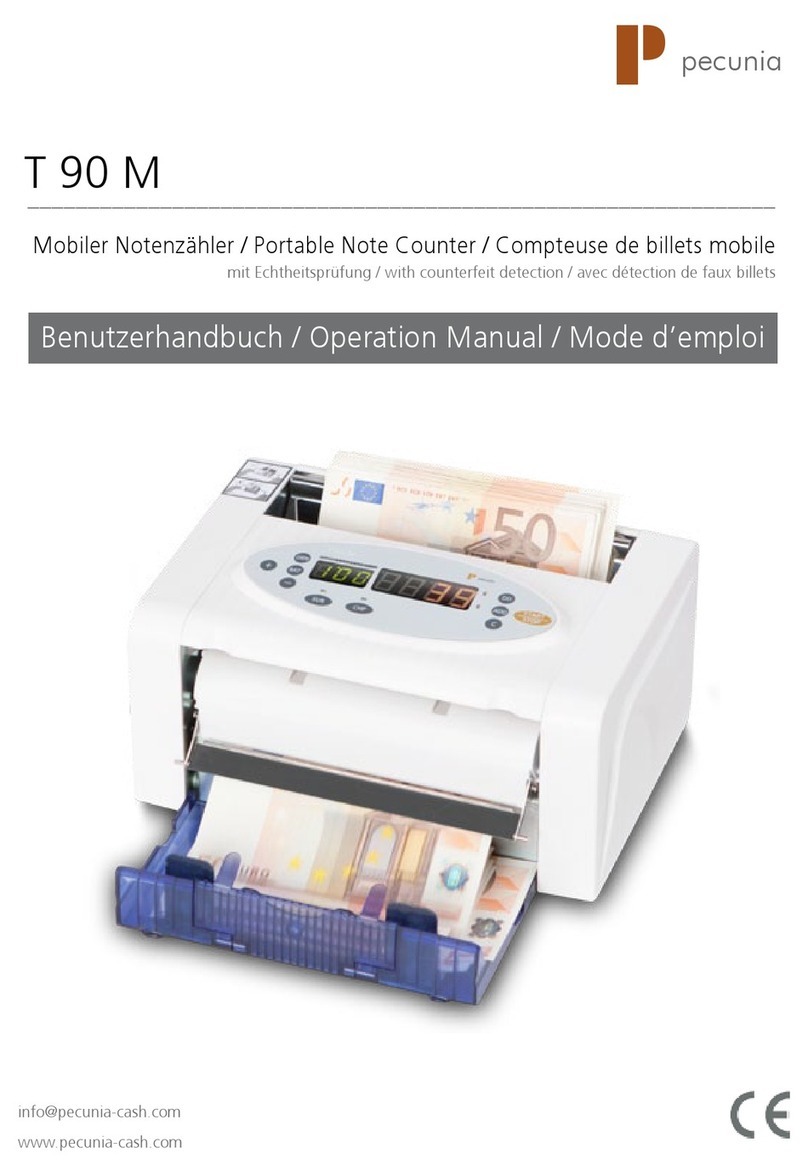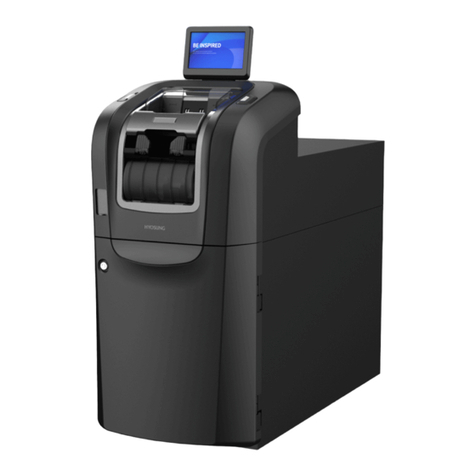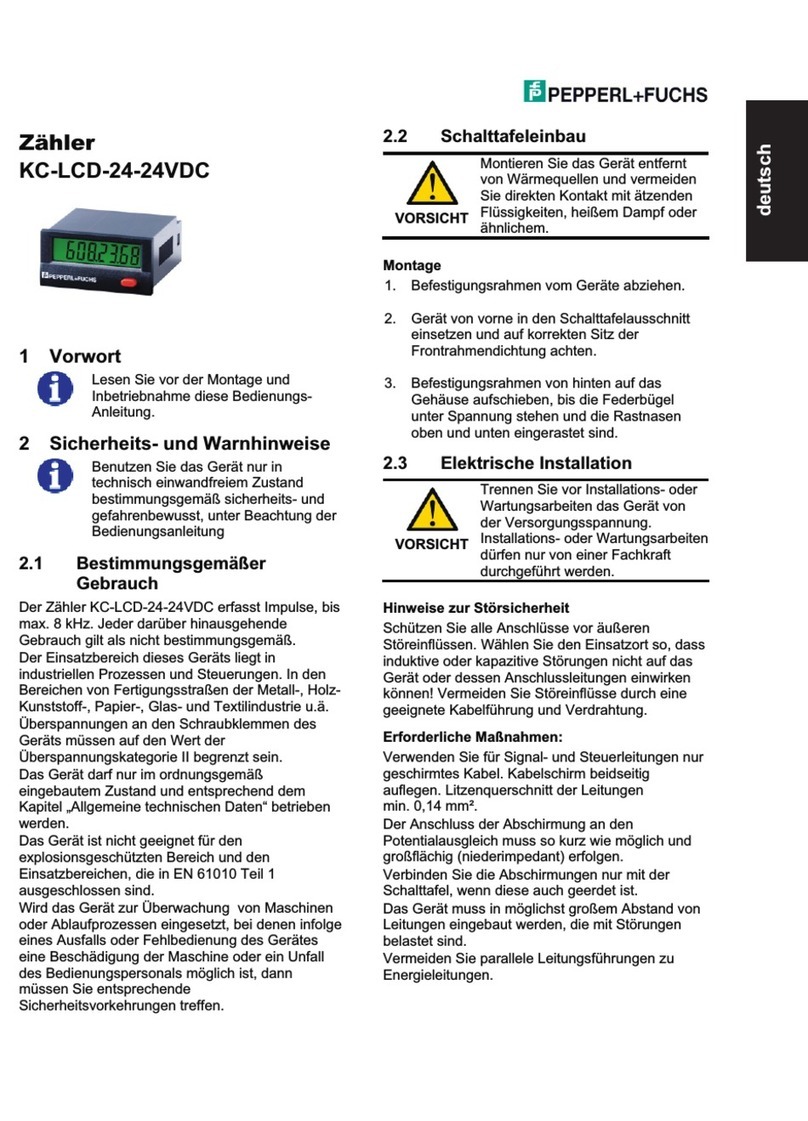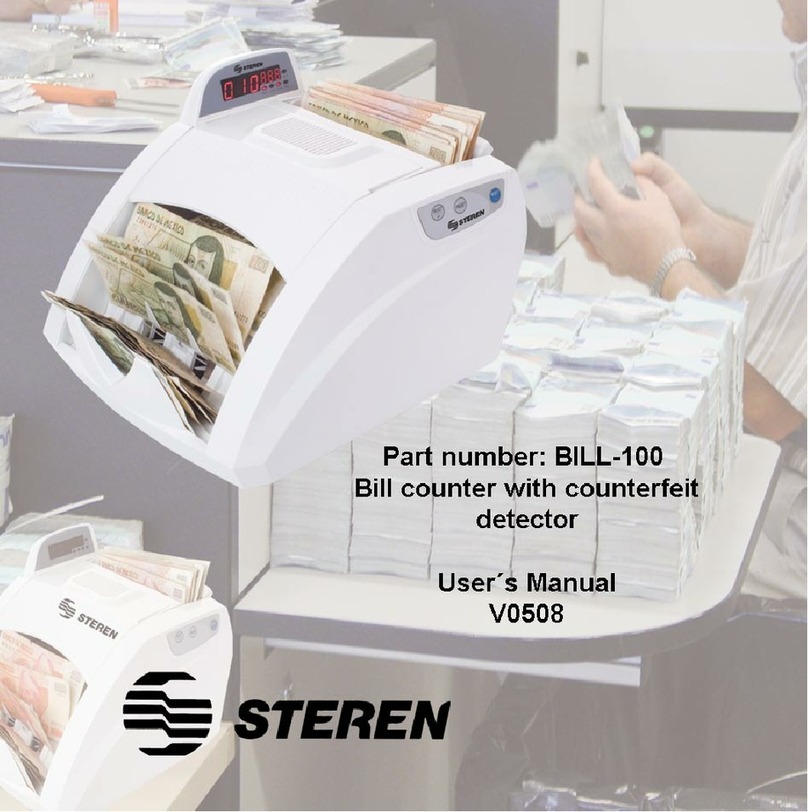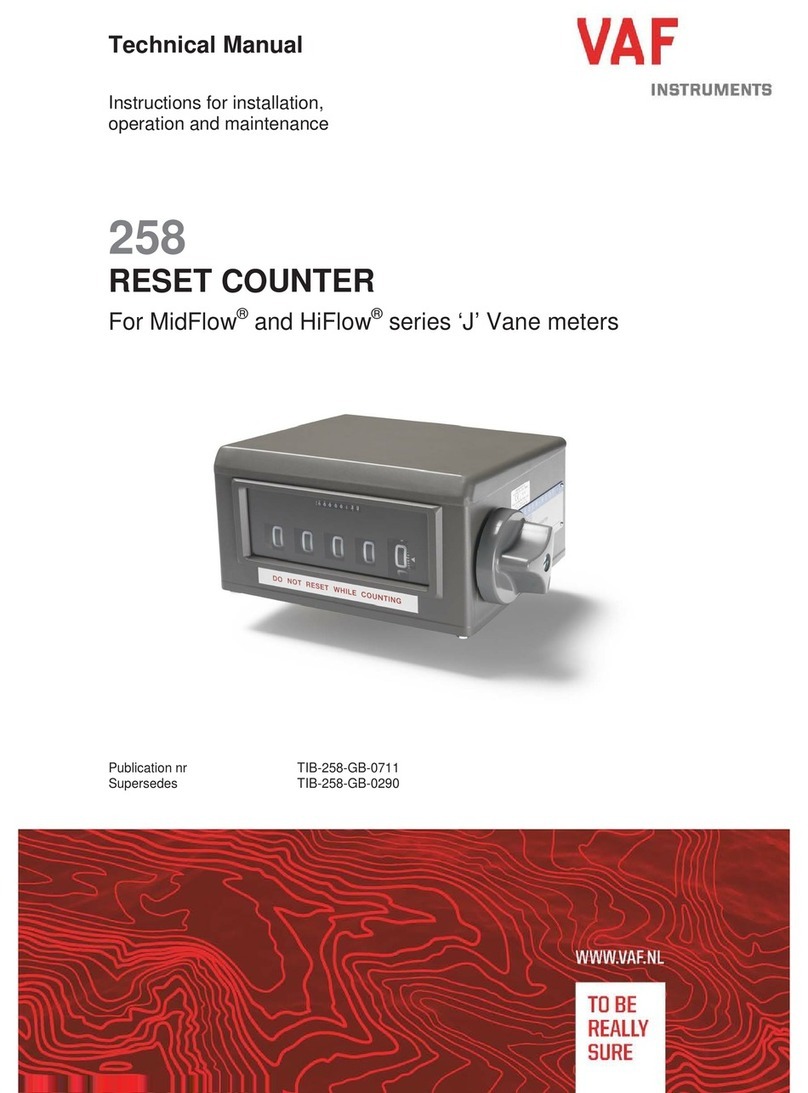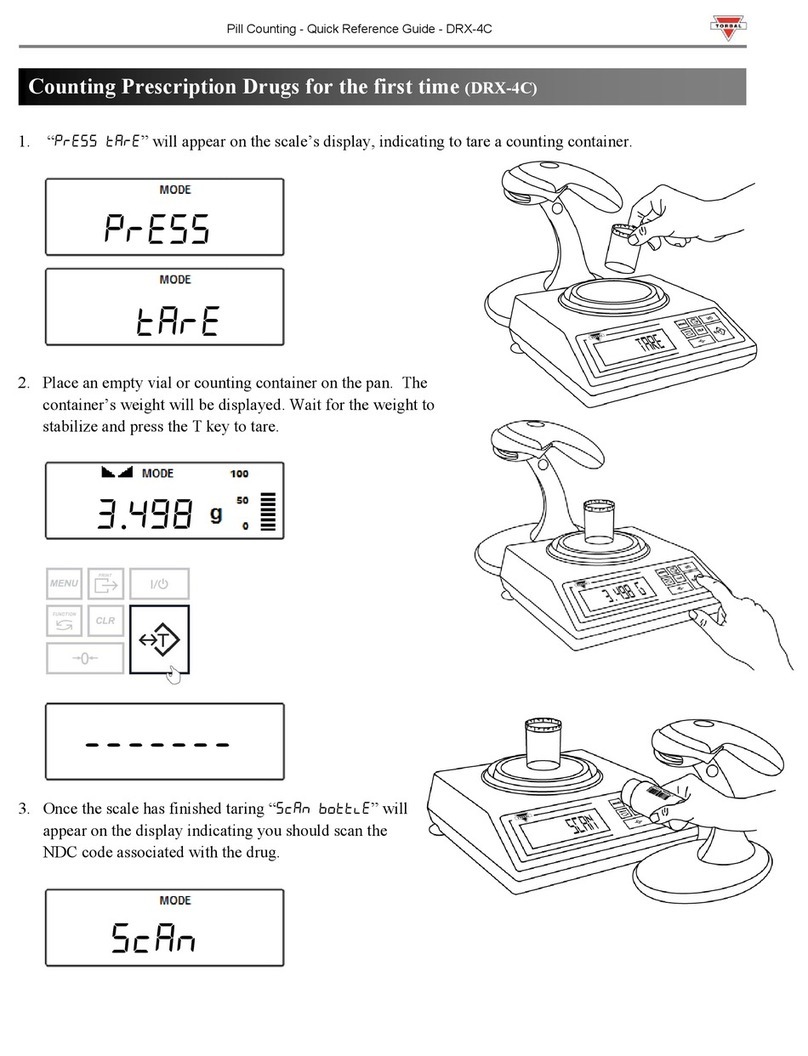Keithley 776 User manual

Model 776Programmable Counter/Timer
Instruction Manual
A GREATER MEASURE OF CONFIDENCE

WARRANTY
Keithley Instruments, Inc. warrants this product to be free from defects in material and workmanship for a period of 1 year
from date of shipment.
Keithley Instruments, Inc. warrants the following items for 90 days from the date of shipment: probes, cables, rechargeable
batteries, diskettes, and documentation.
During the warranty period, we will, at our option, either repair or replace any product that proves to be defective.
To exercise this warranty, write or call your local Keithley representative, or contact Keithley headquarters in Cleveland, Ohio.
You will be given prompt assistance and return instructions. Send the product, transportation prepaid, to the indicated service
facility. Repairs will be made and the product returned, transportation prepaid. Repaired or replaced products are warranted for
the balance of the original warranty period, or at least 90 days.
LIMITATION OF WARRANTY
This warranty does not apply to defects resulting from product modification without Keithley’s express written consent, or
misuse of any product or part. This warranty also does not apply to fuses, software, non-rechargeable batteries, damage from
battery leakage, or problems arising from normal wear or failure to follow instructions.
THIS WARRANTY IS IN LIEU OF ALL OTHER WARRANTIES, EXPRESSED OR IMPLIED, INCLUDING ANY
IMPLIED WARRANTY OF MERCHANTABILITY OR FITNESS FOR A PARTICULAR USE. THE REMEDIES PRO-
VIDED HEREIN ARE BUYER’S SOLE AND EXCLUSIVE REMEDIES.
NEITHER KEITHLEY INSTRUMENTS, INC. NORANY OF ITS EMPLOYEES SHALL BE LIABLE FORANY DIRECT,
INDIRECT, SPECIAL, INCIDENTAL OR CONSEQUENTIAL DAMAGES ARISING OUT OF THE USE OF ITS
INSTRUMENTS AND SOFTWARE EVEN IF KEITHLEY INSTRUMENTS, INC., HAS BEEN ADVISED IN ADVANCE
OF THE POSSIBILITY OF SUCH DAMAGES. SUCH EXCLUDED DAMAGES SHALL INCLUDE, BUTARE NOT LIM-
ITED TO: COSTS OF REMOVAL AND INSTALLATION, LOSSES SUSTAINED AS THE RESULT OF INJURY TO ANY
PERSON, OR DAMAGE TO PROPERTY.
Keithley Instruments, Inc.
• 28775Aurora Road • Cleveland, OH 44139 • 440-248-0400 • Fax: 440-248-6168 • http://www.keithley.com
BELGIUM: Keithley Instruments B.V.
Bergensesteenweg 709 • B-1600 Sint-Pieters-Leeuw • 02/363 00 40 • Fax: 02/363 00 64
CHINA: Keithley Instruments China
Yuan Chen Xin Building, Room 705 • 12Yumin Road, Dewai, Madian • Beijing 100029 • 8610-62022886 • Fax: 8610-62022892
FRANCE: Keithley Instruments Sarl
3, allée des Garays • 91127 Palaiseau Cedex • 01-64 53 20 20 • Fax: 01-60 11 77 26
GERMANY: Keithley Instruments GmbH
Landsberger Strasse 65 • 82110 Germering • 089/84 93 07-40 • Fax: 089/84 93 07-34
GREAT BRITAIN: Keithley Instruments Ltd
The Minster • 58 Portman Road • Reading, Berkshire RG30 1EA • 0118-9 57 56 66 • Fax: 0118-9 59 64 69
INDIA: Keithley Instruments GmbH
Flat 2B, WILOCRISSA • 14, Rest House Crescent • Bangalore 560 001 • 91-80-509-1320/21 • Fax: 91-80-509-1322
ITALY: Keithley Instruments s.r.l.
Viale S. Gimignano, 38 • 20146 Milano • 02-48 39 16 01 • Fax: 02-48 30 22 74
NETHERLANDS: Keithley Instruments B.V.
Postbus 559 • 4200AN Gorinchem • 0183-635333 • Fax: 0183-630821
SWITZERLAND: Keithley Instruments SA
Kriesbachstrasse 4 • 8600 Dübendorf • 01-821 94 44 • Fax: 01-820 30 81
TAIWAN: Keithley Instruments Taiwan
1 Fl. 85 Po Ai Street • Hsinchu, Taiwan, R.O.C. • 886-3572-9077 • Fax: 886-3572-903
9/00

Model 776 Programmable Counter/Timer
Instruction Manual
Serial Prefix T74
©1993, Keithley Instruments, Inc.
All rights reserved.
Cleveland, Ohio, U.S.A.
Fifth Printing, April 2001
Document Number: 776-901-01 Rev. E

Manual Print History
The print history shown below lists the printing dates of all Revisions and Addenda created for this manual. The
Revision Level letter increases alphabetically as the manual undergoes subsequent updates. Addenda, which are
released between Revisions, contain important change information that the user should incorporate immediately into
the manual. Addenda are numbered sequentially. When a new Revision is created, all Addenda associated with the
previous Revision of the manual are incorporated into the new Revision of the manual. Each new Revision includes
a revised copy of this print history page.
Addendum D (Document Number 776-901-02) ............................................ January 1999
Revision E (Document Number 776-901-01)...................................................... April 2001
All Keithley product names are trademarks or registered trademarks of Keithley Instruments, Inc.
Other brand and product names are trademarks or registered trademarks of their respective holders.

Safety Precautions
The following safety precautions should be observed before using
this product and any associated instrumentation.Although some in-
struments and accessories would normally be used with non-haz-
ardous voltages, there are situations where hazardous conditions
may be present.
This product is intended for use by qualified personnel who recog-
nize shock hazards and are familiar with the safety precautions re-
quired to avoid possible injury. Read the operating information
carefully before using the product.
The types of product users are:
Responsible body
is the individual or group responsible for the use
and maintenance of equipment, for ensuring that the equipment is
operated within its specifications and operating limits, and for en-
suring that operators are adequately trained.
Operators
use the product for its intended function. They must be
trained in electrical safety procedures and proper use of the instru-
ment. They must be protected from electric shock and contact with
hazardous live circuits.
Maintenancepersonnel
perform routine procedures on the product
to keep it operating, for example, setting the line voltage or replac-
ing consumable materials. Maintenance procedures are described in
the manual. The procedures explicitly state if the operator may per-
form them. Otherwise, they should be performed only by service
personnel.
Service personnel
are trained to work on live circuits, and perform
safe installations and repairs of products. Only properly trained ser-
vice personnel may perform installation and service procedures.
Keithley products are designed for use with electrical signals that
are rated Installation Category I and Installation Category II, as de-
scribed in the International Electrotechnical Commission (IEC)
Standard IEC 60664. Most measurement, control, and data I/O sig-
nals are Installation Category I and must not be directly connected
to mains voltage or to voltage sources with high transient over-volt-
ages. Installation Category II connections require protection for
high transient over-voltages often associated with local AC mains
connections. The user should assume all measurement, control, and
data I/O connections are for connection to Category I sources un-
less otherwise marked or described in the Manual.
Exercise extreme caution when a shock hazard is present. Lethal
voltage may be present on cable connector jacks or test fixtures.The
American National Standards Institute (ANSI) states that a shock
hazard exists when voltage levels greater than 30V RMS, 42.4V
peak, or 60VDC are present.
A good safety practice is to expect
that hazardous voltage is present in any unknown circuit before
measuring.
Users of this product must be protected from electric shock at all
times. The responsible body must ensure that users are prevented
access and/or insulated from every connection point. In some cases,
connections must be exposed to potential human contact. Product
users in these circumstances must be trained to protect themselves
from the risk of electric shock. If the circuit is capable of operating
at or above 1000 volts,
no conductive part of the circuit may be
exposed.
Do not connect switching cards directly to unlimited power circuits.
They are intended to be used with impedance limited sources.
NEVER connect switching cards directly to AC mains. When con-
necting sources to switching cards, install protective devices to lim-
it fault current and voltage to the card.
Before operating an instrument, make sure the line cord is connect-
ed to a properly grounded power receptacle. Inspect the connecting
cables, test leads, and jumpers for possible wear, cracks, or breaks
before each use.
When installing equipment where access to the main power cord is
restricted, such as rack mounting, a separate main input power dis-
connect device must be provided, in close proximity to the equip-
ment and within easy reach of the operator.
For maximum safety, do not touch the product, test cables, or any
other instruments while power is applied to the circuit under test.
ALWAYS remove power from the entire test system and discharge
any capacitors before: connecting or disconnecting cables or jump-
ers, installing or removing switching cards, or making internal
changes, such as installing or removing jumpers.
Do not touch any object that could provide a current path to the com-
mon side of the circuit under test or power line (earth) ground.Always
make measurements with dry hands while standing on a dry, insulated
surface capable of withstanding the voltage being measured.

The instrument and accessories must be used in accordance with its
specifications and operating instructions or the safety of the equip-
ment may be impaired.
Do not exceed the maximum signal levels of the instruments and ac-
cessories, as defined in the specifications and operating informa-
tion, and as shown on the instrument or test fixture panels, or
switching card.
When fuses are used in a product, replace with same type and rating
for continued protection against fire hazard.
Chassis connections must only be used as shield connections for
measuring circuits, NOT as safety earth ground connections.
If you are using a test fixture, keep the lid closed while power is ap-
plied to the device under test. Safe operation requires the use of a
lid interlock.
If a screw is present, connect it to safety earth ground using the
wire recommended in the user documentation.
The symbol on an instrument indicates that the user should re-
fer to the operating instructions located in the manual.
The symbol on an instrument shows that it can source or mea-
sure 1000 volts or more, including the combined effect of normal
and common mode voltages. Use standard safety precautions to
avoid personal contact with these voltages.
The
WARNING
heading in a manual explains dangers that might
result in personal injury or death.Always read the associated infor-
mation very carefully before performing the indicated procedure.
The
CAUTION
heading in a manual explains hazards that could
damage the instrument. Such damage may invalidate the warranty.
Instrumentation and accessories shall not be connected to humans.
Before performing any maintenance, disconnect the line cord and
all test cables.
To maintain protection from electric shock and fire, replacement
components in mains circuits, including the power transformer, test
leads, and input jacks, must be purchased from Keithley Instru-
ments. Standard fuses, with applicable national safety approvals,
may be used if the rating and type are the same. Other components
that are not safety related may be purchased from other suppliers as
long as they are equivalent to the original component. (Note that se-
lected parts should be purchased only through Keithley Instruments
to maintain accuracy and functionality of the product.) If you are
unsure about the applicability of a replacement component, call a
Keithley Instruments office for information.
To clean an instrument, use a damp cloth or mild, water based
cleaner. Clean the exterior of the instrument only. Do not apply
cleaner directly to the instrument or allow liquids to enter or spill
on the instrument. Products that consist of a circuit board with no
case or chassis (e.g., data acquisition board for installation into a
computer) should never require cleaning if handled according to in-
structions. If the board becomes contaminated and operation is af-
fected, the board should be returned to the factory for proper
cleaning/servicing.
!
2/01

1
l-l
l-2
l-3
1-4
l-5
l-6
1-7
l-8
2 installation
2-1 Introduction .................................................................................................................................................
2-1
2-2 Performance Checks...................................................................................................................................2-I
2-3 Power Requirements...................................................................................................................................2-I
2-4 Grounding Requirements.. .....................................................................................................................
.,.,2-I
2-5 Installation and Mounting ..........................................................................................................................
2-2
2-6 Bench Mounting ..........................................................................................................................................
2-2
2-7 Rack Mounting.. ..........................................................................................................................................
2-2
2-8 Portable Use.................................................................................................................................................
2-2
2-9 Short Term Storage.....................................................................................................................................
2-2
2-10 Long Term Storageor Re-packaging For Shipment ..............................................................................
2-2
2-11 Safety............................................................................................................................................................
2-3
3
3-l
3-2
3-2-l
Table of Contents
General Information
Introduction .................................................................................................................................................
I-1
Instrument and Manual Identification ......................................................................................................1-I
Configuration.. .............................................................................................................................................
l-2
Warranty Information .................................................................................................................................
l-2
Manual Addenda .........................................................................................................................................
I -2
Safety Symbols and Terms ........................................................................................................................
I-2
Inspection .....................................................................................................................................................
l-2
Specifications ..............................................................................................................................................
1-Y
Operation
Introduction 1-l
..................................................................................................................................................
Front Panel Famlllanzatlon........................................................................................................................... 3-l
Controls ....................................................................................................................................................
3-1

3-2-2
3-2-3
3-3
3-3-l
3-4
3-5
3-6
3-6-l
3-6-2
3-7
3-8
3-9
3-10
3-11
3-12
3-13
3-14
3-14-1
3-14-2
3-14-2
3-15
3-16
3-17
3-18
3-19
3-20
3-20-l
3-20-2
3-2 1
3-22
4 IEEE-488 Programming
4-l Introduction .................................................................................................................................................
4-l
4-2 Bus Desdription ...........................................................................................................................................
4-I
4-3 IEEE-488 Bus Lines ...................................................................................................................................
4.2
4-3-l Bus Management Lines ..........................................................................................................................
4-2
4-3-z Handshake Lines .....................................................................................................................................
4-2
4-3-3 Data Lines ................................................................................................................................................
4-3
4-4 Interface Function Codes...........................................................................................................................
4-4
4-5 Software Considerations. ...........................................................................................................................4-4
4-6 Hardware Considerations.. .........................................................................................................................-I-4
4-6-l Typical Controlled System ....................................................................................................................
4-5
4-6-2 Connections .............................................................................................................................................J-5
4-7 Changing GPIB Address............................................................................................................................
4-5
4-8 Bus Commands............................................................................................................................................
4-6
4-8-l Uniline Commands .................................................................................................................................4-G
4-S-2 Universal Multiline Commands............................................................................................................4-7
4-8-3 Addressed Commands............................................................................................................................
4-7
4-8-4 Unaddress Commands............................................................................................................................
4-9
4-8-5 Device Dependent Commands.............................................................................................................
.4-9
4-9 Device-Dependent Command Programming ....
_.
....................................................................................
4-9
4-9-l Function (F) .............................................................................................................................................
4-9
Connectors ...............................................................................................................................................3-2
Display And Indicators ..........................................................................................................................3-2
Rear Panel Familiarization.. ......................................................................................................................
3-3
Connectors and Terminals .....................................................................................................................
3-3
Power-up Procedure ...................................................................................................................................
3-3
Software Reset ............................................................................................................................................3-4
Display Messages.......................................................................................................................................
3-4
IEEE-488 Error Messages..
Error Indtcatmn
...........................................................................................................................................................................................................................................................
:;i
Control Selection ........................................................................................................................................
3-5
Selecting a Function ...................................................................................................................................3-6
Selecting Gate and Delay Time ................................................................................................................
3-8
Setting Trigger Levels.. ..............................................................................................................................3-8
Setting Input Condition Controls .............................................................................................................
3-9
Selecting The Number Of Displayed Digits.. .........................................................................................
3-10
Selecting Measurement Rate.....................................................................................................................3-10
Arming ..........................................................................................................................................................3-l 1
Continuous Arming With the Input Signal..........................................................................................
3-l 1
Front Panel Arming ................................................................................................................................3-l 1
External Arming.. ....................................................................................................................................3-l 1
Using Auto Trigger Level ..........................................................................................................................3-12
Using V PeakA.. .........................................................................................................................................3-12
Using User Gate..........................................................................................................................................3-12
Using Delay .................................................................................................................................................3-13
Using User Delay ........................................................................................................................................3-13
Using Front Panel Set-ups.........................................................................................................................
3-14
StoreSet-ups............................................................................................................................................3-14
Recall Set-ups..........................................................................................................................................3-14
Using The External Reference..................................................................................................................3-14
Changing The GPIB Address....................................................................................................................3-14

4-9-2
4-9-3
4-9-4
4-9-5
4-9-6
4-9-l
4-9-8
4-9-9
4-9-10
4-9-l 1
4-9-12
4-9-13
4-9-14
4-9-15
4-9-16
4-9-17
4-9-18
4-9-19
4-10
4-10-l
4-10-2
4-10-3
4-11
4-11-1
4-11-2
5
5-l
5-2
5-3
5-4
5-5
5-6
5-7
5-8
5-9
5-9-l
5-9-2
5-9-3
5-10
5-10-l
5-10-2
5-10-3
S-10-4
5-10-5
5-10-6
5-10-7
5-10-S
5-10-9
5-10-10
5-10-l 1
S-10-12
Channels A. B Coupling (AC. BC) ......................................................................................................
4-11
Channels A_B Attenuator (AA, BA) ....................................................................................................
4-12
Channels A. B Filter (AF. BF) ..............................................................................................................
4-12
Channels A: B Slope (AS. BS)..............................................................................................................
4-12
Channels A. B Impedance (AI. BI) ......................................................................................................
4-12
Channels A; B Trigger Level (AL.
BL)
...............................................................................................
4-12
Channels A, B Auto Trigger Level (L) ................................................................................................
4-12
GateTime (G, GLJ)..................................................................................................................................
4-12
Delay Time (W, WU) .........................................................
.....................................................................
4-12
V PeakMeasurement Rate (V) ..............................................................................................................4-13
Totalize Mode (M) ..................................................................................................................................
4-13
Ratio Mode (C) ........................................................................................................................................
4-13
Displayed Digits (N) ...............................................................................................................................
4-13
Set-ups (ST. RE)......................................................................................................................................
4-13
Triggering (T) ..........................................................................................................................................
4-l 3
Rate (S).....................................................................................................................................................
4-13
Display Modes (D). .................................................................................................................................
4-14
SRQ Mode (Q) and Serial Poll StatusByte Format.. .........................................................................
4-14
Reading From Model 776 ..........................................................................................................................
4-15
Data Control Commands (R) .................................................................................................................
4-15
Terminator ................................................................................................................................................
4-l 6
Prefix (X) ..................................................................................................................................................
4-17
Front Panel Error Messages......................................................................................................................
4-l 8
ILL INS (Illegal Instruction). ................................................................................................................4-18
ILL PAR (Illegal Parameter) .................................................................................................................
4-18
Maintenance and Performance Checks
Introduction .................................................................................................................................................
5-l
Line Voltage Selection ...............................................................................................................................
5-1
Fuse Replacement .......................................................................................................................................
5-1
Selecting an External Reference...............................................................................................................
5-2
Disassembly Instructions ...........................................................................................................................
5-3
Special Handling Of Static Sensitive Devices ........................................................................................
5-3
Cleaning .......................................................................................................................................................
5-3
Repair and Replacement ............................................................................................................................
5-4
Performance Checks...................................................................................................................................
5-4
Environmental Conditions .....................................................................................................................
5-4
Warm-up Period.......................................................................................................................................
5-4
RecommendedTest Equipment.. ...........................................................................................................
5-4
Performance ChecksProcedure 5-4
.................................................................................................................
Channels A and B Sensitivity Check ...................................................................................................
5-4
Channel C sensitivity Check .................................................................................................................
5-5
Period A. Period A Averaged Operation Check .................................................................................
5-5
Ratio A/B Operation ...............................................................................................................................
5-6
Ratio C/B Operation ...............................................................................................................................
5-7
Pulse A, T.1A to B and Averaged Operation Check..........................................................................
5-7
PhaseA to B Operation Check..............................................................................................................
5-9
Totalize B Operation Check...................................................................................................................
5-9
Auto Trigger Level A and B Operation Check ...................................................................................
5-9
Delay Operation Check ..........................................................................................................................
5-10
User Gate Operation Check ...................................................................................................................5-l 1
Time Base Accuracy Check...................................................................................................................
5-l 1

6 Theory of Operation
6-l
6-2
6-3
6-3-l
6-3-2
6-3-3
6-3-4
6-3-5
6-367
6-4
6-4-l
6-4-2
6-4-3
6-4-4
6-4-S
7
Introduction .................................................................................................................................................
6-1
Overall Functional Description ................................................................................................................
6-l
Analog Circuitry .........................................................................................................................................
6-5
Input Circuits A and B .......................
....................................................................................................
6-S
Input Circuit C (option 2.4Ci).
...............................................................................................................
6-S
10MHz Standard Reference Oscillator ...............................................................................................
6-6
Reference Oscillator Circuit and TCXO (option 2.4G).....................................................................
6-6
Measurement Logic Section ..................................................................................................................
6-13
Power supply ...........................................................................................................................................
6-14
Digital Circuitry ..........................................................................................................................................
6-14
CPU Block Diagram ...............................................................................................................................
6-14
Memory Mapping ....................................................................................................................................
6-14
Address Decoding ...................................................................................................................................
6-14
KeyboardDisplay Interface...................................................................................................................
6-14
IEEE Interface .........................................................................................................................................
6-14
Adjustments and Troubleshooting
7-l
7-2
7-2-l
7-2-2
l-2-3
l-2-4
7-3
7-3-l
l-3-2
7-3-3
7-3-4
l-3-5
l-3-6
7-3-7
7-3-8
l-3-9
7-4
7-4-l
7-5
7-S-l
7-5-2
7-s-3
7-s-4
7-s-s
7-S-6
7-s-7
6
Introduction .................................................................................................................................................
7-l
Adjustments .................................................................................................................................................
7-l
Environmental Conditions. ....................................................................................................................
7-l
Warm-up Period.......................................................................................................................................
7-l
RecommendedTest Equipment .............................................................................................................
7-l
Adjustment Procedures ..........................................................................................................................
7-l
Adjustment Procedure................................................................................................................................
7-3
Power Supply Adjustment .....................................................................................................................
7-3
Trigger Level A Adjustment ..................................................................................................................
7-3
Trigger Level B Adjustment ..................................................................................................................
7-3
Trigger Level A Offset Adjustment ......................................................................................................
7-3
Trigger Level B Offset Adjustment ......................................................................................................
7-3
Input A xl0 High Frequency Adjustment ...........................................................................................
7-3
Input
B xl0 High Frequency Adjustment ............................................................................................
7-4
Standard- SPPM Time BaseAdjustment ...........................................................................................
7-4
TCXO.Time Base Adjustment (option 2.4G) .....................................................................................
7-4
Troubleshooting ..........................................................................................................................................
7-4
RecommendedTest Equipment .............................................................................................................
7-4
Troubleshooting Procedure .......................................................................................................................
7-S
Power Supply Checks.............................................................................................................................
7-S
Digital Circuitry and Display Checks..................................................................................................
7-6
Standard SPPM Reference Oscillator Checks..
.................................................................................
7-6
SO0MHz Reference Oscillator and TCXO Checks ...........................................................................
7-6
Trigger Level Checks .............................................................................................................................
7-6
Signal Conditioning and Input Circuit Checks...................................................................................
7-6
Measurement Logic Section Checks ....................................................................................................
7-6
Parts List
8-l General .........................................................................................................................................................
8-l
8-2 Ordering Information .................................................................................................................................
8-1
8-3 Parts Description.. .......................................................................................................................................
8-1

General Information
l-l. Introduction
This manual provides operating and maintenance infor-
matron
for the Model
716
Programmable
Counter/Timer. Section 1is a general description of the
instrument. Section 2 and 3 obtain installation and op-
erating instructions. IEEE programming is explained in
Section 4. Maintenance and performance checks are
provided in Section 5. The theoF of operation is de-
scribed in Section 6. Section 7 oullines calibration and
troubleshooting procedures. Section 8contains tablesof
replaceable parts. Section 9 contains schematic and
component location diagrams.
Model 776 is aFendigit microprocessor basedfully-
programmable. three-channel Universal Counrcr I
Timer. The instrument mcasurcswith a vev high reso-
lution and precision the following paramctcrs: Frc-
quency A. Frequency B. Frequency C. Period A. Pulse-
width. Time interval A to B. Total counts B. Ratio A/B.
Ratio C/B. Phase A to B and Amplitude peaks. An
averaging function is available for improved resolution
in time measurement: resohes intervals of pica sec-
onds. Various repetitive tests. no matter how complex.
aregreatly simplified b>~utiliziog any of the IOpre-pro-
grammed front panel set-up. Set-ups are stored in a
non-volatile memory and can be recalled by a simple
ke.sstroke.
Model 776 utilizes a combination of two measure-
ment techniques in order to always achieve maximum
display resolution. Somefunctions. such as Frequent!
measurement function. can be displayed with up to ten
digits. Such resolution can be gained from frequencies
aslow as0.01 Hz to more than 225 MHz. The reciprocal
technique is being usedin low frequency mcasurcmcnts.
up to exactly 120 MHz. where the measurement tcch-
nique is changed to conventional measurement tcch-
nique. Model 776 measuresfrcqucncies of input signals
with minimum resolution of nine digits in one second
of gate time. With the TCXO
time
baseof the Model
776l2.46. the displayed result in largely enhanced.both
in terms of stability and accuracy.
In Model 776. the lraditionally featured decade
steps of gale times. are replaced by a more flerible
variable gate time. This feature permits a choice from
500 internally pre-selected gate interwls. or an! ester-
nal gate intcnal which is applied to a rear panel BNC
conneclor. Internal gate times range from 100 ps to IO
s. External gate expands this range to 1000 s. Trigger
leveI my be selected maounll~~or left to bc aulomali-
call? adjusted. by the instrument. to the optimum level.
thus eliminating false lriggcring on unknown signals.
NOTE
This manual provides acomplclc dc-
scription of all fcrturcs of the 776
Series. Therefore. several of the fea-
tures that aredescribed in the follow-
ing paragraphs may not be installed
in your instrument.
1-2. Instrument Identification
These KeithIcy’ instmmcnts are identified by a serial
number. which is located on lhe rear panel. The lvo
most significant digits (Txs) identify instrumcnl modi-
I-I

General Information
Page 1-2
fication. If this prefix differs from that listed on the title
page of this manual, there are differences between this
manual and your instrument.
1-3. Configuration
There are two configurations available for the Model 776:
•
Model 776 - Two-channel 225 MHz programmable
counter/timer.
•
Model 776/2.4G - Same as above with 2.4 GHz Chan-
nel C and TCXO time base.
•
Model 776/2.4G/R - Same as above with rear panel
inputs.
1-4. Warranty Information
Warranty information is located on the inside front cover
of this instructions manual. Should your Model 776
require warranty service, contact the Keithley representa-
tive or authorized repair facility in your area for further
information. When returning the instrument for repair, be
sure to fill out and include the service form at the back of
this manual to provide the repair facility with the neces-
sary information.
1-5. Manual Addenda
Any improvements or changes concerning the instrument
or manual will be explained in an addendum included with
the manual. Be sure to note these changes and incorporate
them into this manual.
1-6. Safety Symbols AndTerms
The following symbols and terms may be found on an
instrument or used in this manual.
The symbol on an instrument indicates that the user
should refer to the operating instructions located in the
manual.
The
WARNING
heading used in this manual explains
dangers that might result in personal injury or death.
Always read the associated information very carefully
before performing the indicated procedure.
The
CAUTION
heading used in this manual explains
hazards that could damage the instrument. Such damage
may invalidate the warranty.
1-7. Inspection
The Model 776 was carefully inspected, both electrically
and mechanically before shipment. After unpacking all
items from the shipping carton, check for any obvious
signs of physical damage that may have occurred during
transit. (Note: There may be a protective film over the
display lens, which can be removed.) Report any damage
to the shipping agent immediately. Save the original
packing carton for possible future re-shipment. The
following items are included with every Model 776 order:
!
Table 1-1.
Model 776 Specifications
INPUT CHARACTERISTICS
(Channel A & B)
RANGEDC coupled
AC coupled 1 M
Ω
50
Ω
SENSITIVITY (X1)
0 to 200 MHz
200 MHz to 225 MHz
5 ns Minimum Pulse Width
SIGNAL OPERATING RANGE
(X1)
(X10)
DYNAMIC RANGE (x1)
0 to 100 MHz
100 MHz to 225 MHz
: 0 to 225 MHz.
: 30 Hz to 225 MHz.
: 1 MHz to 225 MHz.
: 50 mV rms sine wave.
: 75 mV rms sine wave.
: 75 mVp-p.
: -5.00 Vdc to +5.00 Vdc.
: -50.0 Vdc to +50.0 Vdc.
: 75 mV to 5 Vp-p.
: 150 mV to 2.5 Vp-p.

Table l-l.
Model 776 Specificntions (continued)
IMPEDANCE : 1 MQ or 50 .Q nominal shunted by less than 4.5pF.
switchable.
LOW PASS FILTER : -3 dB NOMINAL at 100 KHz. switchable.
COUPLING : AC or DC. switchable.
DAMAGE LEVEL (AC or DC)
(Xl) : DC to 2 KHz - 200 V (DC + pk AC):
2 KHz to 100 KHz - lsi05 V rms Hz/Freq:
Above 100 KHz - S V rms.
(X10) : DC to 20 KHz - 200 V (DC + pk AC):
20 KHz to 100 KHz - 4~10~ V rms Hz/Freq:
abo\:e 100 KHz - 50 V rms.
50 R : 5 v rms
TRIGGER LEVEL CHARACTERISTICS
(Channel A and B)
MANUAL TRIGGER (auto trigger off)
(Xl) : -5.00 Vdc to +5.00 Vdc:
(X10) : -50.0 Vdc to i50.0 Vdc.
Setting Accuracy : Xl. * (35 mV +2% of reading): X10, + (350 mV +2% of
reading).
Resolution (X 1) : 10 mV: (X10): 100 tnV.
Preset (Xl) : 0.00 Vdc: (X10) 00.0 Vdc.
Trigger Slope : Independent selection of positive or negative slope. switchable
AUTO TRIGGER
Frequency Range
DC Coupled : 100 Hz to 150 MHz.
AC Coupled 1 MO : 100 Hz to 150 MHz.
50 n : 1 MHz to 150 MHz.
Auto Trigger Level Range : 150 vp-p.
Minimum Amplitude : I00 mV rms sine wave. 280 mVp-p.
ATTENUATOR
Manual : X1 or Xl0 NOMINAL. selectable.
Auto : Attenuator is automalically enabled when in Auto Trigger
Mode.
Auto Attenuator Sensitivity : Attenuator is switched when peak input signal exceeds 5.I
VP-P.
NOTES:
1. Auto trigger is disabled in the following functions: Totalize B and Frequency C.
2. Auto trigger function requires that a repetitive signal be present at the input connector.
FREQUENCY A & FREQUENCY B
Measurement Technique : Reciprocal. below I20 MHz and in User Gate. and in Hold
operating modes: Conventional, above I20 MHz.
Measurement technique is automatically selected by the
instrument.
Range : 0.01 Hz to 225 MHz.
1-3

General Information
Table l-l.
Model 776 Specifications (continued)
LSD(‘) Displayed
Reciprocal
Conventional
Resolution
Accuracy
FREQUENCY C
(available with Model 776/2.46)
Range
Input Impedance
Sensitivity
Dynamic Range
VSWR
Dama e Level
LSD(’ Displayed
7
Resolution
Accuracy
4
ns s freaw
gate time. e.g min 9 digits in one second of
gate time.
l/gate time.
* LSD * (1.4 x Trig errorc2) s Frequency)
gate time
i resolution i Time Base error’3’ s Frequent)
50 MHz to 2.4 GHz.
SO.f2. AC coupled.
15 mV to 2.4 GHz.
15
mV rms to 4 V rms.
<2:1 (typically l.S:l).
AC. 5 V rms: DC. f40 V.
Same as for Frequency A & B.
Same as for Frequency A & B.
Same as for Frequency A & B.
PERIOD A, PULSE A, TIME INTERVAL A to B
Range: Period A. Pulse A
Time Interval A to B
LSD(‘) Displayed
Below 20 s
Above 20 s
Resolution
Below 20 s
Above 20 s
Accuracy
Time Delay
Internal
Internal Range
Preset Position
External
External Range
5 ns to 2000 s.
0 ns
to
2000 s.
1 ns:
5 s Time s 10.” s.
+2 LSD + start trigger error@) i stop trigger error?
; LSD.
f (Time Base errorc3)
(4)
1 Time) i Trig level timing error
f 1 ns * resolution.
Active only with Time Measurements - single. First input
transition opens the gate. Delay inhibits the consequent
transitions.
500 internal pre-programmed delay intervals can be inserted
between START and STOP of Time Interval A to B. Inputs
during delay are ignored.
100 ps to 100 s.
1 s.
User selectable delay intervals can be applied through rear
panel BNC connector.
100 ps
to
2000 s.
Pagel-4

General Information
Table l-l.
Model 776 Specijjcotions (continued)
TIME MEASUREMENTS AVERAGED
PERIOD A AVERAGED
&!?‘) Displayed
Resolution
Accuracy
Number of Periods Averaged
PULSE A, TIME INTERVAL
Range Pulse A
Time Interval A to B
LSD(‘) Displayed
Resolution
Accuracy
Dead Time Stop to Start
Number of Samples Averaged
PHASE A to B AVERAGED
Range example
Frequency Range
LSD(‘) Displayed
Resolution
Accuracy
Number of Cycles Averaged
Minimum Amplitude
TOTALIZE B
Frequency Range
Totalizing Range
Gate Modes
Infinite
Gated by A
Gated by AA
Gating Transition
Dead Time Stop to Sta#)
: 8 ns to 10 s
: 4 ns s Period.
gate time e.g miu 9 digits in 1 second of gate time.
: f LSD * il.4 s Trig error(‘) s Period)
eate time
It resolution + (Time Base errorc3) s Period).
A to B AVERAGED
5 ns to 10 s
-3 ns to 10 s (A and B signals must have the same
repetition rate).
4 ns/ J
3~(1 LSD + 10 ps).
+ (Time Base Error”) x Time) zt 1 ns i!resoiution
+ Trigger Level Timing Errorc4) f (Trigger error) / fi
20 ns minimum.
N = gate time s Frequency.
0 to 360” s (1 - 20 ns s Frequency A).
0 to 359.99Oat 1 KHz: 0 to 180.0’ at 25 MHz.
0.1 Hz to 25 MHz. A and B signals must have the same
frequency.
4 ns s 360’ s (1 +fi)
gate time or 0.01”. whichever is greater.
+ 1 LSD.
k resolution f (1 ns s Frequency A s 360’) *
It Trigger Level Timing Error(4) s FrequencyA x 360”) ?
+ (Trigger error(2) s Frequency A s 36OO)
\iN
N = gate time s Frequency A.
100 mV rms sine wave.
0 tn 120 MHz.
0 to lOI - 1.
Totalizing on B indefinitely.
Totalizing on B between a pair of two consecutive
transitions of the opposite direction on A.
Totalizing on B between a pair of two consecutive
transitions of the same direction on A.
Positive or Negative transitions. selectable.
20 ns min from stop transition to the nest start transition.
1-5

General Information
Table l-l.
Model
776
Specifications (continued)
LSD displayed
Resolution
AccuracyInfinite
Gated by A, Gated by AA
: 1
count
of channel B input signal.
: 1 LSD.
: Same as LSD.
: * pulse repetition rate B x Trigger error(2) A
total counts B
RATIO AIB
Frequency Range
A
B
LSD(‘) displayed
Resolution
Accuracy
RATIO C/B
Frequency Range
C
B
LSD(‘) displayed
Resolution and Accuracy
V PEAK A
Function
Frequency range
Slow Rate
Fast Rate
Dynamic Range
Resolution xl
Accuracy
GATE TIME
Internal Gate Time
Internal Range
Preset Position
External Gate Time
External Range
External Input
External Gate Delay(‘)
: 0.01 Hz to 225 MHz:
: 0.01 Hz to 125 MHz.
4 x Ratio--__
Frequency A s gat;z:‘”
: + LSD ,Trieeer B x Ratio
gate time
: Sameas resolution.
: SOMHz to 2.4 GHz;
: 10 Hz to 225 MHz.
4 s Ratio
Frequency B s gate time
: k LSD.
: Displays simultaneously. with 3 digits each, the maximum
and minimum peaks of Channel A input signal. Decimal
points and polarity are autotiaticallg displayed.
: 40 Hz to 10 MHz:
: 100 Hz to 10 MHz.
: 280 mV p-p to 51 V p-p.
: 10 mV: x10: 100 mV. Attenuator is activated automalically
if either the positive or the negative peaks of the input
signal exceeds fS.l V or when the peak to peak voltage
exceeds 5.1 V.
: + resolution i O.l(Vpas pli - Vneg& * 35 mV.
: 500 pm-programmed gate time intervals.
: 100 ps to 10 s or one period of the input. which ever is
longer.
: 1 s.
: User selectable gate time intemals. ranging from 100 ps
to 1000 5.
: 100 ps to 2000 s. External gate not available with Time
measurements - single slmt. Totalize B and Phase A to B.
Rear panel BNC connector: accepts TTL level signals.
j cl0 ps.
Pagel-6

Table l-l. A,fodel776
.Speci@?tions (continued)
EXTERNAL ARMING (TRIGGER)
Function
I”PUl Impedance
Level
Logic
Minimum Pulse Width
Trigger Delay(‘)
STANDARD TIME BASE
Frequency
Aging Rate
Temperature Stabilit)
Line Voltage
Clock IN/OUT
External Time Base Input
Time Base Out
TCXO TIME BASE
(available with Model 776/2.46)
Frequency
Aging Rate
Temperature Stability
Line Voltage
Clock IN/OUT
External Time Base Input
Time Base Out
GPIB INTERFACE
Programmable Controls
Multiline Commands
Uniline Commands
Interface Functions
Data Output Format Reading
Gate/Delay Time and Trigger Level
Data Output
Single Shot
Normal Mode
Fast Mode
Address Selection
GENERAL
Display Rate
Normal
Hold
Fast
Arms the instrument when set to HOLD mode
Via Rear panel BNC.
1 KC2nominal.
TTL.
Positive true
10 ps.
<SOps.
10 MHz.
<I s IO-‘/month.
<5 s 10’6 0 to 50 “C.
<I X 10.’ for 10% change (short term).
Selected with an internal switch.
Rear Panel BNC accepts 10 MHz TTL.
10 MHz appros 2 V from a 51 0 source.
10 MHz.
<I s lO~‘/month: <I x 10e6/year.
Cl s 10‘6. 0 to 50 “C.
<I s 10“‘for 10% change (short term).
Selected with an internal switch.
Rear Panel BNC accepts 5 or 10 MHz ‘ITL. Selected via
an internal switch.
10 MHz appros 2 V from a 51 n source.
: All front panel controls except POWER switch.
: DCL. LLO. SDC. GET. GTL. UNT. UNL> SPE. SPD.
: IFC. REN. EOI. SRQ. ATN.
: SHl. AHl. T6. TEO.L4. LEO. SRI, RLI. PPO.DCI. DTI.
CO.El.
: With prefix 18 ASCII characters plus terminator: Without
prefix - 1-t ASCII characters plus terminator.
: With prefix - 9 ASCII characters plus terminator;
Without prefix - 5 ASCII characters plus terminator.
One reading processed after trigger.
Approximately four readings/second. formatted.
Up to 100 reading/second. formatted.
Front panel programming. Address is stored in a
non-volatile memory.
Approximately four measurementsper second:
Single shot measurement. taken with each press of RESET:
Up to 100 measuremeals per second.

Table l-1.
Model 776 SpeciJiconons (continued)
Arming : Each channel is armed by it’s own signal
Reset : Clears display and re-cycles measurement.
Trigger Level Outputs : DC Outputs via rear panel terminals. not adjusted for
attenuators.
Accuracy : DC (Xl) *35 mV * 2% of trigger level reading.
Output Impedance : 1 KQ 1%.
Display : 10 digits seven segtnents LED. 0.56” high. 2 digits for
exponent.
Displayable Digits : Selectable from 3 to 10 most significant digits.
Gate : LED indicator lights when gate is open.
Stored Set-ups : Ten measurement set-ups. including trig levels, gate/delay
time. input conditioning and measurement rate may be
stored in memory and subsequently recalled. When AC
mains power is removed. a non-volatile memory preserves
the stored set-ups for a typical period of 3 years.
Operating Temperature : 0 to 50 OCambient. 0 to 80% relative humidity.
Storage Temperature : -25 to 65 “C.
Power Requirements : llY230 V rms &lo% (rear panel switch select) 48-60 Hz.
30 W maximum.
Warm-Up : I hour to rated accuracy and stability.
Dimensions : 3.5” s 8.3” s 15.4” (H s W s D) 89 s 211 s 391 m”m.
Rack Mount Dimensions : 3.5” s 19” (H s W) 89 x 483 m”m.
Weight: approximately 8 lb (3.5 kg).
Accessories Furnished: Power Cord, Operating Manual.
DEFINITION OF TERMS
(1) LSD : Unit value of least significant digit. Calculation should be
rounded as follows 1 to <5 Hz becomes I Hz. 5 ns to
cl0 ns becomes 10 ns etc.
(2) Trigger Error
d(ei*+On*)
Input slew rate at trigger point
Where: ei is the rms noise voltage of the counter‘s input
channel (250 pV typ.) en is the rms noise of the input
signal for 225 MHz band-width.
(3) Time Base Error : Maximum fractional frequency change in time base
frequency due to all errors: e.g aging. temperature. line
voltage etc.
(4) Trigger Level Timing Error (xl) : 18mV _.~~+ ~?rnV
Input slew rate at - Input slew rate at
start trigger point stop trigger point
5) External arming (trigger) delay : Delay from the positive going slope of the arming signal to
the internal gate open signal.
(6) External gate delay : Delay from the positive going slope of the gating signal to
the internal gate open signal.
(7) Dead Time : Minimum time between measurement which the counter is
busy in performing the measurement. The counter will not
at this time respond lo any input transition.
Pagel-8

General Informnlion
l
Model 776 Programmable CounterfIimer with line
cord.
. Model 776 Instructions Manual. NOTE
If an additional manual is required, order:
. Keithley part number 776-901-00. All specifications in the following
table apply after awarm-up period of
1hour and at ambient temperature of
1-8. Specifications
Instrument specifications are listed in Table I-l. These
specifications are the performance standards or limits
against which the instrument is tested.
25Y f50C.
1-9

Installation
2-1. Introduction
This section contain information and instructions nec-
essary for the installation and shipping of the Model
776. Details areprovidedforpowerconnection. ground-
ing safety requirements. installation information. and
x-packing instructions for storage or shipment.
2-2. Performance Checks
The instrument was carefully inspected for mechanical
and electrical performance before shipment from the
factory. It should be free of physical defects and in
perfect electrical order upon receipt. Check the instru-
ment for damage in transit and perform the electrical
procedures outlined in Section 5. If there is indication
of damageor deficiency. seethe warranty in this manual
and notify your local Keithley field engineering rep-
resentative or the factory
CAUTION
It is recommended that the operator
be fully familiar with the specifica-
tions and all sections of this manual.
Failure to do so may compromise the
warranty and the accuracy which
Keithley hasengineered into your in-
strument.
2-3. Power Requirements
The instrument may be operated from any one of the
following sources: a. 103.5 to 126.5 Volts (1IS Volts
nominal) b. 207 to 253 Volts (230 Volts nominal).
The instrument operates over the power mains frc-
quency range of 18 to 63 Hr. Always verify that the
operating power mains voltage is the sameasthat speci-
fied on the rear panel voltage selector switch.
CAUTION
Failure to switch the instrument to
match the operating line voltage will
damagethe instrument and may void
the warranty.
The instrument should be operated
from a power source with its neutral
at or near ground (earth potential).
The instrument is not intended for
operation from two phases of a
multi-phase ac sqstcm or across the
legs of a single-phase. three-wire ac
power system. Crest factor (ratio of
peak voltage to rms) should be typi-
cally within the range of 1.3 to I.6
at 10% of the nominal rms mains
voltage.
24. Grounding Requirements
To insure the safety of operating personnel. the U.S.
O.S.H.A. (Occupational Safety and Health) rcquire-
ment and good engineering practice mandate that the
instrument panel and enclosure be “earth” grounded.
All Keithley instruments are provided with an Uuder-
writers Laboratories (U.L. and V.D.E) listed lhrec-con-
ductor power cable. which when plugged into an ap-
propriate power rcceptaclc. grounds the instrument.
2-l
Table of contents
Other Keithley Cash Counter manuals
Popular Cash Counter manuals by other brands

Anly
Anly H5KLR user manual
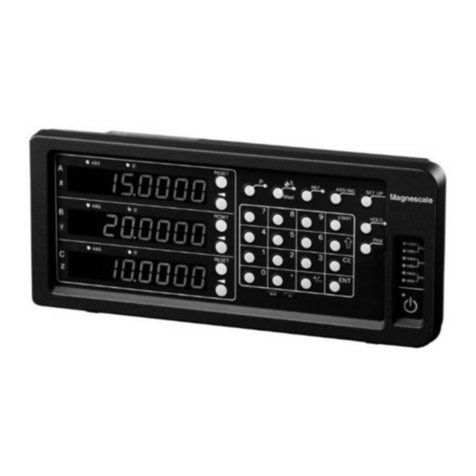
Magnescale
Magnescale LY72 quick start guide

Royal Sovereign
Royal Sovereign RBC-1003 owner's manual

Garland
Garland ED Series Installation & operation manual
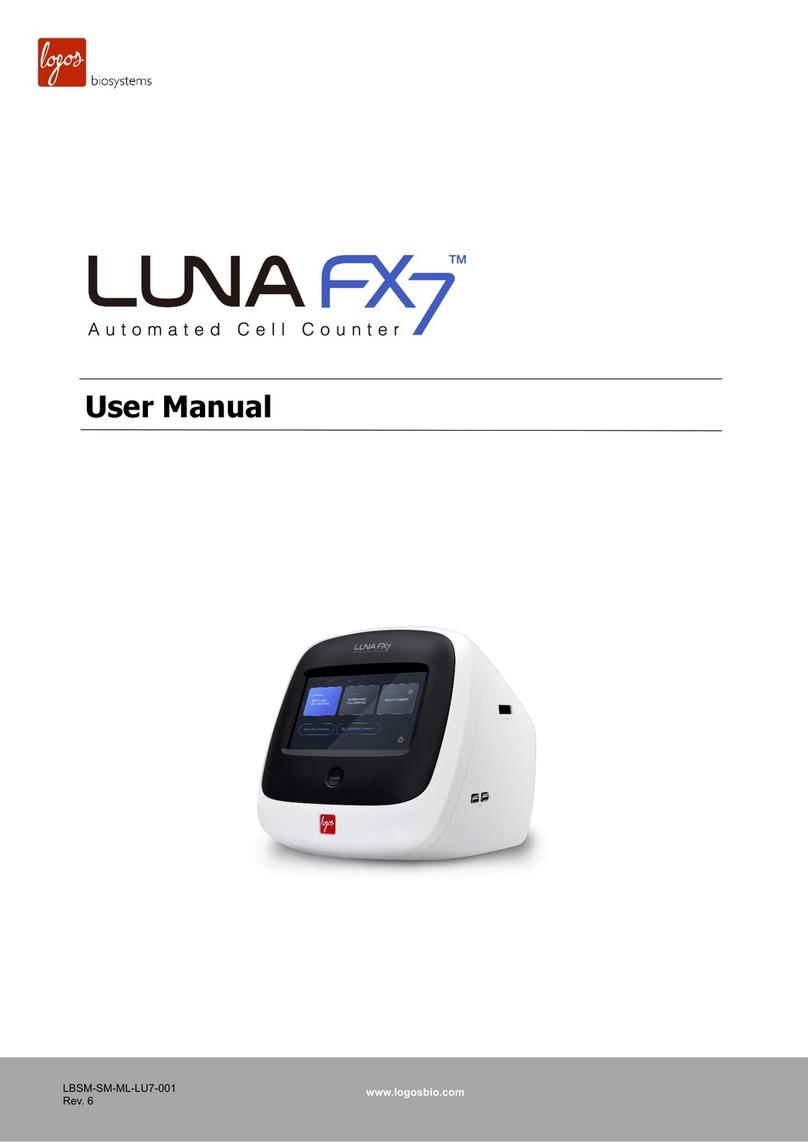
logos biosystems
logos biosystems LUNA FX7 Series user manual
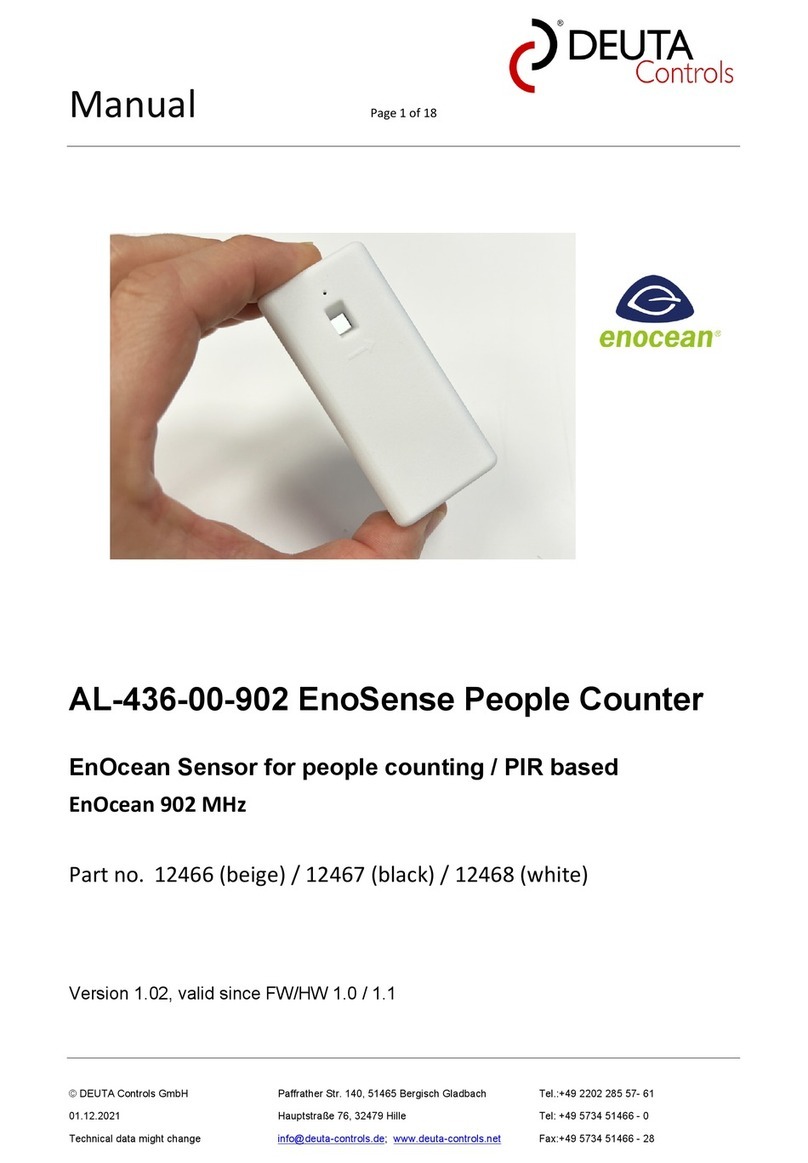
DEUTA Controls
DEUTA Controls enocean EnoSense AL-436-00-902 manual

